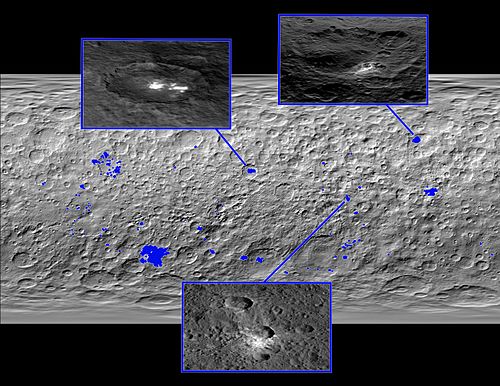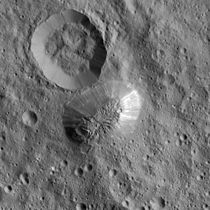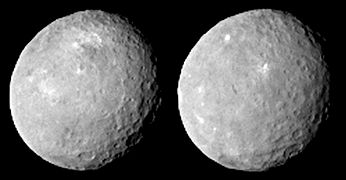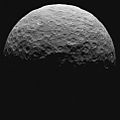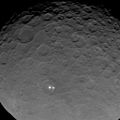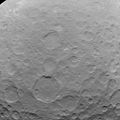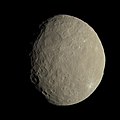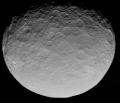Ceres (dwarf planet)
 Ceres in true color in 2015[a] | |||||||||
| Discovery[1] | |||||||||
|---|---|---|---|---|---|---|---|---|---|
| Discovered by | Giuseppe Piazzi | ||||||||
| Discovery date | 1 January 1801 | ||||||||
| Designations | |||||||||
| (1) Ceres | |||||||||
| Pronunciation | /ˈsɪəriːz/ | ||||||||
Named after | Cerēs | ||||||||
| |||||||||
| |||||||||
| Adjectives | Cererean, -ian /sɪˈrɪəriən/ | ||||||||
| Symbol | |||||||||
| Orbital characteristics[2] | |||||||||
| Epoch 27 April 2019 (JD 2458600.5) | |||||||||
| Aphelion | 2.9796467093 AU (445,749,000 km) | ||||||||
| Perihelion | 2.5586835997 AU (382,774,000 km) | ||||||||
| 2.7691651545 AU (414,261,000 km) | |||||||||
| Eccentricity | 0.07600902910 | ||||||||
| 4.61 yr 1683.14570801 d | |||||||||
| 466.6 d 1.278 yr | |||||||||
Average orbital speed | 17.905 km/s | ||||||||
| 77.37209589° | |||||||||
| Inclination | 10.59406704° to ecliptic 9.20° to invariable plane[3] | ||||||||
| 80.3055316° | |||||||||
| 73.5976941° | |||||||||
| Proper orbital elements[4] | |||||||||
Proper semi-major axis | 2.7670962 AU | ||||||||
Proper eccentricity | 0.1161977 | ||||||||
Proper inclination | 9.6474122° | ||||||||
Proper mean motion | 78.193318 deg / yr | ||||||||
Proper orbital period | 4.60397 yr (1681.601 d) | ||||||||
Precession of perihelion | 54.070272 arcsec / yr | ||||||||
Precession of the ascending node | −59.170034 arcsec / yr | ||||||||
| Physical characteristics | |||||||||
| Dimensions | (964.4 × 964.2 × 891.8) ± 0.2 km[2] | ||||||||
| 939.4±0.2 km[2] | |||||||||
| 469.73 km[5] | |||||||||
| 2,770,000 km2[6] | |||||||||
| Volume | 434,000,000 km3[6] | ||||||||
| Mass | (9.3835±0.0001)×1020 kg[2] 0.00016 Earths 0.0128 Moons | ||||||||
Mean density | 2.162±0.008 g/cm3[2] | ||||||||
Equatorial surface gravity | 0.28 m/s2[6] 0.029 g | ||||||||
| 0.36±15[7][b] (estimate) | |||||||||
Equatorial escape velocity | 0.51 km/s[6] | ||||||||
| 9.074170±0.000001 h[2] | |||||||||
Equatorial rotation velocity | 92.61 m/s[6] | ||||||||
| ≈4°[9] | |||||||||
North pole right ascension | 291.42744°[10] | ||||||||
North pole declination | 66.76033°[5] | ||||||||
| 0.090±0.0033 (V-band)[11] | |||||||||
| |||||||||
| C[13] | |||||||||
| 3.34[2] | |||||||||
| 0.854″ to 0.339″ | |||||||||
Ceres (/ˈsɪəriːz/;[16] minor-planet designation: 1 Ceres) is the largest object in the main asteroid belt that lies between the orbits of Mars and Jupiter. With a diameter of 940 km (580 mi), Ceres is both the largest of the asteroids and the only dwarf planet inside Neptune's orbit.[c] It is the 25th-largest body in the Solar System within the orbit of Neptune.[17]
Ceres was the first asteroid to be discovered (by Giuseppe Piazzi at Palermo Astronomical Observatory on 1 January 1801).[18] It was originally considered a planet, but was reclassified as an asteroid in the 1850s after many other objects in similar orbits were discovered.
Ceres is the only object in the asteroid belt rounded by its own gravity,[19] although Vesta and perhaps other asteroids were so in the past. From Earth, the apparent magnitude of Ceres ranges from 6.7 to 9.3, peaking once at opposition every 15 to 16 months, which is its synodic period.[14] Thus even at its brightest, it is too dim to be seen by the naked eye, except under extremely dark skies. Ceres has been classified as a C-type asteroid[13] and, due to the presence of clay minerals, as a G-type asteroid.[20]
Ceres appears to be partially differentiated into a muddy (ice-rock) mantle/core and a less-dense but stronger crust that is at most 30 percent ice.[12] It probably no longer has an internal ocean of liquid water, but there is brine that can flow through the outer mantle and reach the surface.[21] The surface is a mixture of water ice and various hydrated minerals such as carbonates and clay. Cryovolcanoes such as Ahuna Mons form at the rate of about one every fifty million years. In January 2014, emissions of water vapor were detected from several regions of Ceres.[22] This was unexpected because large bodies in the asteroid belt typically do not emit vapor, a hallmark of comets. The atmosphere, however, is transient and of the minimal kind known as an exosphere.[21]
The robotic NASA spacecraft Dawn entered orbit around Ceres on 6 March 2015.[23][24][25]
History
Discovery
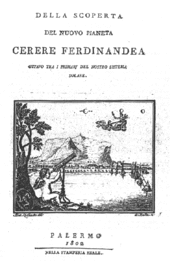
Johann Elert Bode, in 1772, first suggested that an undiscovered planet could exist between the orbits of Mars and Jupiter.[26] Kepler had already noticed the gap between Mars and Jupiter in 1596.[26] Bode based his idea on the Titius–Bode law which is a now-discredited hypothesis that was first proposed in 1766. Bode observed that there was a regular pattern in the size of the orbits of known planets, and that the pattern was marred only by the large gap between Mars and Jupiter.[26][27] The pattern predicted that the missing planet ought to have an orbit with a radius near 2.8 astronomical units (AU).[27] William Herschel's discovery of Uranus in 1781[26] near the predicted distance for the next body beyond Saturn increased faith in the law of Titius and Bode, and in 1800, a group headed by Franz Xaver von Zach, editor of the Monatliche Correspondenz, sent requests to twenty-four experienced astronomers (whom he dubbed the "celestial police"), asking that they combine their efforts and begin a methodical search for the expected planet.[26][27] Although they did not discover Ceres, they later found several large asteroids.[27]
One of the astronomers selected for the search was Giuseppe Piazzi, a Catholic priest at the Academy of Palermo, Sicily. Before receiving his invitation to join the group, Piazzi discovered Ceres on 1 January 1801.[28][29] He was searching for "the 87th [star] of the Catalogue of the Zodiacal stars of Mr la Caille", but found that "it was preceded by another".[26] Instead of a star, Piazzi had found a moving star-like object, which he first thought was a comet.[30] Piazzi observed Ceres a total of 24 times, the final time on 11 February 1801, when illness interrupted his observations. He announced his discovery on 24 January 1801 in letters to only two fellow astronomers, his compatriot Barnaba Oriani of Milan and Johann Elert Bode of Berlin.[31] He reported it as a comet but "since its movement is so slow and rather uniform, it has occurred to me several times that it might be something better than a comet".[26] In April, Piazzi sent his complete observations to Oriani, Bode, and Jérôme Lalande in Paris. The information was published in the September 1801 issue of the Monatliche Correspondenz.[30]
By this time, the apparent position of Ceres had changed (mostly due to Earth's orbital motion), and was too close to the Sun's glare for other astronomers to confirm Piazzi's observations. Toward the end of the year, Ceres should have been visible again, but after such a long time it was difficult to predict its exact position. To recover Ceres, Carl Friedrich Gauss, then 24 years old, developed an efficient method of orbit determination.[30] In only a few weeks, he predicted the path of Ceres and sent his results to von Zach. On 31 December 1801, von Zach and Heinrich W. M. Olbers found Ceres near the predicted position and thus recovered it.[30]
The early observers were only able to calculate the size of Ceres to within an order of magnitude. Herschel underestimated its diameter as 260 km in 1802, whereas in 1811 Johann Hieronymus Schröter overestimated it as 2,613 km.[32][33]
Name
Piazzi originally suggested the name Cerere Ferdinandea for his discovery, after the goddess Ceres (Roman goddess of agriculture, Cerere in Italian, who was believed to have originated in Sicily and whose oldest temple was there) and King Ferdinand of Sicily.[26][30] "Ferdinandea", however, was not acceptable to other nations and was dropped. Ceres was called Hera for a short time in Germany.[34] In Modern Greek, it is called Dímitra (Δήμητρα), after Demeter, the Greek equivalent of the Roman Cerēs. (To distinguish the asteroid 1108 Demeter in Greek, the classical form of the name, Dimítir (Δημήτηρ) is used.) All other languages but Chinese use a variant of Ceres/Cerere: e.g. Russian Церера Tseréra, Arabic سيريس Sīrīs, Japanese ケレス Keresu. Even Chinese uses the Latin name for the goddess, as 刻瑞斯 kèruìsī, but it calques the asteroid as 'grain-god(dess) star' (穀神星 gǔshénxīng).
The regular adjectival forms of the name are Cererian[35][36] /sɪˈrɪəriən/[37] and Cererean[38] (with the same pronunciation),[39] both derived from the Latin oblique stem Cĕrĕr-.[40] The irregular form Ceresian /sɪˈriːziən/ is occasionally seen for the goddess (as in the sickle-shaped Ceresian Lake), as are, by analogy with cereal, the forms Cerean /ˈsɪəriən/[41] and Cerealian /sɛriˈeɪliən/.[42]
The old astronomical symbol of Ceres is a sickle, ⟨⚳⟩,[43] similar to Venus' symbol ⟨♀⟩ but with a break in the circle. It has a variant ⟨⚳⟩, reversed under the influence of the initial letter 'C' of 'Ceres'. These symbols were later replaced with the generic asteroid symbol of a numbered disk, ⟨①⟩.[30][44]
Cerium, a rare-earth element discovered in 1803, was named after Ceres.[45][d] In the same year another element was also initially named after Ceres, but when cerium was named, its discoverer changed the latter to palladium, after the second asteroid, 2 Pallas.[47]
Classification
The categorization of Ceres has changed more than once and has been the subject of some disagreement. Johann Elert Bode believed Ceres to be the "missing planet" he had proposed to exist between Mars and Jupiter, at a distance of 419 million km (2.8 AU) from the Sun.[26] Ceres was assigned a planetary symbol, and remained listed as a planet in astronomy books and tables (along with 2 Pallas, 3 Juno, and 4 Vesta) for half a century.[26][30][48]

As other objects were discovered in the neighborhood of Ceres, it was realized that Ceres represented the first of a new class of objects.[26] In 1802, with the discovery of 2 Pallas, William Herschel coined the term asteroid ("star-like") for these bodies,[48] writing that "they resemble small stars so much as hardly to be distinguished from them, even by very good telescopes".[49] As the first such body to be discovered, Ceres was given the designation 1 Ceres under the modern system of minor-planet designations. By the 1860s, the existence of a fundamental difference between asteroids such as Ceres and the major planets was widely accepted, though a precise definition of "planet" was never formulated.[48]
The 2006 debate surrounding Pluto and what constitutes a planet led to Ceres being considered for reclassification as a planet.[50][51] A proposal before the International Astronomical Union for the definition of a planet would have defined a planet as "a celestial body that (a) has sufficient mass for its self-gravity to overcome rigid-body forces so that it assumes a hydrostatic equilibrium (nearly round) shape, and (b) is in orbit around a star, and is neither a star nor a satellite of a planet".[52] Had this resolution been adopted, it would have made Ceres the fifth planet in order from the Sun.[53] This never happened, however, and on 24 August 2006 a modified definition was adopted, carrying the additional requirement that a planet must have "cleared the neighborhood around its orbit". By this definition, Ceres is not a planet because it does not dominate its orbit, sharing it as it does with the thousands of other asteroids in the asteroid belt and constituting only about 25% of the belt's total mass.[54] Bodies that met the first proposed definition but not the second, such as Ceres, were instead classified as dwarf planets.
Ceres is the largest asteroid in the Main Belt.[13] It has sometimes been assumed that Ceres was reclassified as a dwarf planet, and that it is therefore no longer considered an asteroid. For example, a news update at Space.com spoke of "Pallas, the largest asteroid, and Ceres, the dwarf planet formerly classified as an asteroid",[55] whereas an IAU question-and-answer posting states, "Ceres is (or now we can say it was) the largest asteroid", though it then speaks of "other asteroids" crossing Ceres' path and otherwise implies that Ceres is still considered an asteroid.[56] The Minor Planet Center notes that such bodies may have dual designations.[57] The 2006 IAU decision that classified Ceres as a dwarf planet also implied that it is simultaneously an asteroid. It introduces the category of small Solar System body, as objects that are neither planets nor dwarf planets, and states that they 'currently include most of the Solar System asteroids'. The only object among the asteroids that would prevent all asteroids from being SSSBs is Ceres. Lang (2011) comments "the [IAU has] added a new designation to Ceres, classifying it as a dwarf planet. ... By [its] definition, Eris, Haumea, Makemake and Pluto, as well as the largest asteroid, 1 Ceres, are all dwarf planets", and describes it elsewhere as "the dwarf planet–asteroid 1 Ceres".[58] NASA continues to refer to Ceres as an asteroid,[59] as do various academic textbooks.[60][61] However, NASA has at least once referred to Vesta as the largest asteroid.[62]
Orbit
| Element type |
a (in AU) |
e | i | Period (in days) |
|---|---|---|---|---|
| Proper[4] | 2.7671 | 0.116198 | 9.647435 | 1,681.60 |
| Osculating[2] (Epoch 23 July 2010 ) |
2.7653 | 0.079138 | 10.586821 | 1,679.66 |
| Difference | 0.0018 | 0.03706 | 0.939386 | 1.94 |

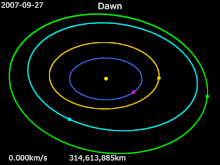
Dawn · Earth · Mars · 4 Vesta · 1 Ceres
Ceres follows an orbit between Mars and Jupiter, within the asteroid belt and closer to the orbit of Mars, with a period of 4.6 Earth years.[2] The orbit is moderately inclined (i = 10.6° compared to 7° for Mercury and 17° for Pluto) and moderately eccentric (e = 0.08 compared to 0.09 for Mars).[2]
The diagram illustrates the orbits of Ceres (blue) and several planets (white and gray). The segments of orbits below the ecliptic are plotted in darker colors, and the orange plus sign is the Sun's location. The top left diagram is a polar view that shows the location of Ceres in the gap between Mars and Jupiter. The top right is a close-up demonstrating the locations of the perihelia (q) and aphelia (Q) of Ceres and Mars. In this diagram (but not in general), the perihelion of Mars is on the opposite side of the Sun from those of Ceres and several of the large main-belt asteroids, including 2 Pallas and 10 Hygiea. The bottom diagram is a side view showing the inclination of the orbit of Ceres compared to the orbits of Mars and Jupiter.
Ceres was once thought to be a member of an asteroid family.[63] The asteroids of this family share similar proper orbital elements, which may indicate a common origin through an asteroid collision some time in the past. Ceres was later found to have spectral properties different from other members of the family, which is now called the Gefion family after the next-lowest-numbered family member, 1272 Gefion.[63] Ceres appears to be merely an interloper in the Gefion family, coincidentally having similar orbital elements but not a common origin.[64]
Resonances
Ceres is in a near-1:1 mean-motion orbital resonance with Pallas (their proper orbital periods differ by 0.2%).[65] However, a true resonance between the two would be unlikely; due to their small masses relative to their large separations, such relationships among asteroids are very rare.[66] Nevertheless, Ceres is able to capture other asteroids into temporary 1:1 resonant orbital relationships (making them temporary trojans) for periods up to 2 million years or more; fifty such objects have been identified.[67]
Transits of planets from Ceres
Mercury, Venus, Earth, and Mars can all appear to cross the Sun, or transit it, from a vantage point on Ceres. The most common transits are those of Mercury, which usually happen every few years, most recently in 2006 and 2010. The most recent transit of Venus was in 1953, and the next will be in 2051; the corresponding dates are 1814 and 2081 for transits of Earth, and 767 and 2684 for transits of Mars.[68]
Rotation and axial tilt
The rotation period of Ceres (the Cererian day) is 9 hours and 4 minutes. It has an axial tilt of 4°.[9] This is small enough for Ceres's polar regions to contain permanently shadowed craters that are expected to act as cold traps and accumulate water ice over time, similar to the situation on the Moon and Mercury. About 0.14% of water molecules released from the surface are expected to end up in the traps, hopping an average of 3 times before escaping or being trapped.[9]
Geology
Ceres has a mass of 9.39×1020 kg as determined from the Dawn spacecraft.[69] With this mass Ceres composes approximately a third of the estimated total 3.0 ± 0.2×1021 kg mass of the asteroid belt,[70] or 1.3% of the mass of the Moon. Ceres is close to being in hydrostatic equilibrium, and thus to being a dwarf planet. However, there are some deviations from an equilibrium shape that have yet to be fully explained.[19] Among Solar System bodies, Ceres is intermediate in size between the smaller asteroid Vesta and the larger moon Tethys, and approximately the size of the large trans-Neptunian object Orcus. Its surface area is approximately the same as the land area of India or Argentina.[71] In July 2018, NASA released a comparison of physical features found on Ceres with similar ones present on Earth.[72]
Ceres is the smallest object likely to be in hydrostatic equilibrium, being 600 km smaller and less than half the mass of Saturn's moon Rhea, the next smallest likely (but unproven) object.[73] Modeling has suggested Ceres could have a small metallic core from partial differentiation of its rocky fraction,[74][75] but the data is consistent with a mantle of hydrated silicates and no core.[19]
Surface

The surface of Ceres is "remarkably" homogeneous on a global scale, and is rich in carbonates and ammoniated phyllosilicates that have been altered by water.[19] However, water ice in the regolith varies from approximately 10% in polar latitudes to much drier, even ice-free, in the equatorial regions.[12][19] Another large-scale variation is found in three large shallow basins (planitia) with degraded rims; these may be cryptic craters, and two of the three have higher than average ammonium concentrations.[19]
The water ocean that is thought to have existed early in Ceres's history should have left an icy layer under the surface as it froze. The fact that Dawn found no evidence of such a layer suggests that Ceres's original crust was at least partially destroyed by later impacts, thoroughly mixing the ice with the salts and silicate-rich material of the ancient seafloor and the material beneath.[19]
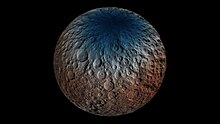
Ceres' surface is warm enough that surface ice sublimates in the near vacuum. Material left behind by sublimation of could explain the dark surface of Ceres compared to the icy moons of the outer Solar System.[citation needed]
Studies by the Hubble Space Telescope reveal that graphite, sulfur, and sulfur dioxide are present on Ceres's surface. The former is evidently the result of space weathering on Ceres's older surfaces; the latter two are volatile under Cererian conditions and would be expected to either escape quickly or settle in cold traps, and are evidently associated with areas with recent geological activity.[76]
Observations prior to Dawn

Prior to the Dawn mission, only a few surface features had been unambiguously detected on Ceres. High-resolution ultraviolet Hubble Space Telescope images taken in 1995 showed a dark spot on its surface, which was nicknamed "Piazzi" in honor of the discoverer of Ceres.[20] This was thought to be a crater. Later near-infrared images with a higher resolution taken over a whole rotation with the Keck telescope using adaptive optics showed several bright and dark features moving with Ceres' rotation.[77][78] Two dark features had circular shapes and were presumed to be craters; one of them was observed to have a bright central region, whereas another was identified as the "Piazzi" feature.[77][78] Visible-light Hubble Space Telescope images of a full rotation taken in 2003 and 2004 showed eleven recognizable surface features, the natures of which were then undetermined.[11][79] One of these features corresponds to the "Piazzi" feature observed earlier.[11]
These last observations indicated that the north pole of Ceres pointed in the direction of right ascension 19 h 24 min (291°), declination +59°, in the constellation Draco, resulting in an axial tilt of approximately 3°.[11] Dawn later determined that the north polar axis actually points at right ascension 19 h 25 m 40.3 s (291.418°), declination +66° 45' 50" (about 1.5 degrees from Delta Draconis), which means an axial tilt of 4°.[80]
Observations by Dawn
Dawn revealed that Ceres has a heavily cratered surface; nevertheless, Ceres does not have as many large craters as expected, likely due to past geological processes.[81][82] An unexpectedly large number of Cererian craters have central pits, perhaps due to cryovolcanic processes, and many have central peaks.[83] Ceres has one prominent mountain, Ahuna Mons; this peak appears to be a cryovolcano and has few craters, suggesting a maximum age of no more than a few hundred million years.[84][85] A later computer simulation has suggested that there were originally other cryovolcanoes on Ceres that are now unrecognisable due to viscous relaxation.[86] Several bright spots have been observed by Dawn, the brightest spot ("Spot 5") located in the middle of an 80-kilometer (50 mi) crater called Occator.[87] From images taken of Ceres on 4 May 2015, the secondary bright spot was revealed to actually be a group of scattered bright areas, possibly as many as ten. These bright features have an albedo of approximately 40%[88] that are caused by a substance on the surface, possibly ice or salts, reflecting sunlight.[89][90] A haze periodically appears above Spot 5, the best known bright spot, supporting the hypothesis that some sort of outgassing or sublimating ice formed the bright spots.[90][91] In March 2016, Dawn found definitive evidence of water molecules on the surface of Ceres at Oxo crater.[92][93]
On 9 December 2015, NASA scientists reported that the bright spots on Ceres may be related to a type of salt, particularly a form of brine containing magnesium sulfate hexahydrite (MgSO4·6H2O); the spots were also found to be associated with ammonia-rich clays.[94] Near-infrared spectra of these bright areas were reported in 2017 to be consistent with a large amount of sodium carbonate (Na
2CO
3) and smaller amounts of ammonium chloride (NH
4Cl) or ammonium bicarbonate (NH
4HCO
3).[95][96] These materials have been suggested to originate from the recent crystallization of brines that reached the surface from below.[97][98][99][98][100]
Carbon
Organic compounds (tholins) were detected on Ceres in Ernutet crater,[101][102] and most of the planet's surface is extremely rich in carbon,[103] with approximately 20% carbon by mass in its near surface.[104][105] The carbon content is more than five times higher than in carbonaceous chondrite meteorites analyzed on Earth.[105] The surface carbon shows evidence of being mixed with products of rock-water interactions, such as clays.[104][105] This chemistry suggests Ceres formed in a cold environment, perhaps outside the orbit of Jupiter, and that it accreted from ultra-carbon-rich materials in the presence of water, which could provide conditions favorable to organic chemistry.[104][105] Its presence on Ceres is evidence that the basic ingredients for life can be found throughout the universe.[103]

"Spot 1" (top row) ("cooler" than surroundings); "Spot 5" (bottom) ("similar in temperature" as surroundings) (April 2015) |
Internal structure


The active geology of Ceres is driven by ice and brines, with an overall salinity of around 5%. Altogether, Ceres is approximately 40% or 50% water by volume, compared to 0.1% for Earth, and 73% rock by weight.[12]
The fact that the surface has preserved craters smaller than 300 km in diameter indicate that the outermost layer of Ceres is on the order of 1000 times stronger than water ice. This is consistent with a mixture of silicates, hydrated salts and methane clathrates, with no more than approximately 30% water ice.[19]
The thickness and density of the crust is not well constrained. There are competing 2-layer and 3-layer models of the Cererian interior, not counting a possible small metallic core.
Three-layer model
In the three-layer model, Ceres is thought to consist of an inner muddy mantle of hydrated rock, such as clays, an intermediate layer of brine and rock (mud) down to a depth of at least 100 km, and an outer, 40-km thick crust of ice, salts and hydrated minerals.[107] It's unknown if it contains a rocky or metallic core, but the low central density suggests it may retain about 10% porosity.[12] One study estimated the densities of the core and mantle/crust to be 2.46–2.90 and 1.68–1.95 g/cm3, with the mantle and crust being 70–190 km thick. Only partial dehydration (expulsion of ice) from the core is expected, while the high density of the mantle relative to water ice reflects its enrichment in silicates and salts.[8] That is, the core, mantle and crust all consist of rock and ice, though in different ratios.
The mineral composition can only be determined indirectly for the outer 100 km. The 40-km thick solid outer crust is a mixture of ice, salts, and hydrated minerals. Under that is a layer that may contain a small amount of brine. This extends to a depth of at least the 100-km limit of detection. Under that is thought to be a mantle dominated by hydrated rocks such as clays. It is not possible to tell if Ceres' deep interior contains liquid or a core of dense material rich in metal.[108]
Two-layer model
In one two-layer model, Ceres consists of a core of chondrules and a mantle of mixed ice and micron-sized solid particulates ("mud"). Sublimation of ice at the surface would leave a deposit of hydrated particulates perhaps 20 meters thick. There are range to the extent of differentiation that is consistent with the data, from a large, 360-km core of 75% chondrules and 25% particulates and a mantle of 75% ice and 25% particulates, to a small, 85-km core consisting nearly entirely of particulates and a mantle of 30% ice and 70% particulates. With a large core, the core–mantle boundary should be warm enough for pockets of brine. With a small core, the mantle should remain liquid below 110 km. In the latter case, a 2% freezing of the liquid reservoir would compress the liquid enough to force some to the surface, producing cryovolcanism.[109]
The model may be compared to estimates that Ceres has averaged one cryovolcano every 50 million years.[110]
Another model notes that Dawn data is consistent with a partial differentiation of Ceres into a volatile-rich crust and a denser mantle of hydrated silicates. A range of densities for the crust and mantle can be calculated from the types of meteorite thought to have impacted Ceres. With CI-class meteorites (density 2.46 g/cc), the crust would be approximately 70 km thick and have a density of 1.68 g/cc; with CM-class meteorites (density 2.9 g/cc), the crust would be approximately 190 km thick and have a density of 1.9 g/cc. Best-fit from admittance modeling yields a crust approximately 40 km thick with a density of approximately 1.25 g/cc, and a mantle/core density of approximately 2.4 g/cc.[19]
Atmosphere
There are indications that Ceres has a tenuous water vapor atmosphere outgassing from water ice on the surface, making it an active asteroid.[111][112][113][114]
Surface water ice is unstable at distances less than 5 AU from the Sun,[115] so it is expected to sublime if it is exposed directly to solar radiation. Water ice can migrate from the deep layers of Ceres to the surface, but escapes in a very short time.
In early 2014, using data from the Herschel Space Observatory, it was discovered that there are several localized (not more than 60 km in diameter) mid-latitude sources of water vapor on Ceres, which each give off approximately 1026 molecules (or 3 kg) of water per second.[116][117][e] Two potential source regions, designated Piazzi (123°E, 21°N) and Region A (231°E, 23°N), have been visualized in the near infrared as dark areas (Region A also has a bright center) by the W. M. Keck Observatory. Possible mechanisms for the vapor release are sublimation from approximately 0.6 km2 of exposed surface ice, or cryovolcanic eruptions resulting from radiogenic internal heat[116] or from pressurization of a subsurface ocean due to growth of an overlying layer of ice.[120] Surface sublimation would be expected to be lower when Ceres is farther from the Sun in its orbit, whereas internally powered emissions should not be affected by its orbital position. The limited data available was more consistent with cometary-style sublimation;[116] however, subsequent evidence from Dawn strongly suggests ongoing geologic activity could be at least partially responsible.[121][122]
Studies using Dawn's gamma ray and neutron detector (GRaND) reveal that Ceres is accelerating electrons from the solar wind regularly; although there are several possibilities as to what is causing this, the most accepted is that these electrons are being accelerated by collisions between the solar wind and a tenuous water vapor exosphere.[123]
In 2017, Dawn confirmed that Ceres has a transient atmosphere that appears to be linked to solar activity. Ice on Ceres can sublimate when energetic particles from the Sun hit exposed ice within craters.[124]
Origin and evolution
Ceres is a surviving protoplanet (planetary embryo) that formed 4.56 billion years ago, the only one surviving in the inner Solar System, with the rest either merging to form terrestrial planets or being ejected from the Solar System by Jupiter.[125] However, its composition is not consistent with a formation in the asteroid belt. It seems rather that Ceres formed as a centaur, most likely between the orbits of Jupiter and Saturn, and was scattered into the asteroid belt as Jupiter migrated outward.[12] The discovery of ammonia salts in Occator crater supports an origin in the outer Solar System.[126] However, the presence of ammonia ices can be attributed to impacts by comets, and ammonia salts are more likely to be native to the surface.[127]
The geological evolution of Ceres was dependent on the heat sources available during and after its formation: friction from planetesimal accretion, and decay of various radionuclides (possibly including short-lived extinct radionuclides such as aluminium-26). These are thought to have been sufficient to allow Ceres to differentiate into a rocky core and icy mantle soon after its formation.[75] This process may have caused resurfacing by water volcanism and tectonics, erasing older geological features.[citation needed] Ceres's relatively warm surface temperature implies that any of the resulting ice on its surface would have gradually sublimated, leaving behind various hydrated minerals like clay minerals and carbonates.[citation needed]
Today, Ceres has become considerably less geologically active, with a surface sculpted chiefly by impacts; nevertheless, evidence from Dawn reveals that internal processes have continued to sculpt Ceres's surface to a significant extent, in stark contrast to Vesta[128] and of previous expectations that Ceres would have become geologically dead early in its history due to its small size.[129] There are significant amounts of water ice in its crust.[102]
Potential habitability
Although not as actively discussed as a potential home for microbial extraterrestrial life as Mars, Europa, Enceladus, or Titan, there is evidence that Ceres' icy mantle was once a watery subterranean ocean. The remote detection of organic compounds and the presence of water with 20% carbon by mass in its near surface, could provide conditions favorable to organic chemistry.[104][105]
Observation and exploration
Observation

When in opposition near its perihelion, Ceres can reach an apparent magnitude of +6.7.[131] This is generally regarded as too dim to be visible to the naked eye, but under ideal viewing conditions, keen eyes with 20/20 vision may be able to see it. The only other asteroids that can reach a similarly bright magnitude are 4 Vesta and, when in rare oppositions near their perihelions, 2 Pallas and 7 Iris.[132] When in conjunction, Ceres has a magnitude of around +9.3, which corresponds to the faintest objects visible with 10×50 binoculars; thus it can be seen with such binoculars in a naturally dark and clear night sky around new moon.
Some notable observations and milestones for Ceres include the following:
- 1984 November 13: An occultation of a star by Ceres observed in Mexico, Florida and across the Caribbean.[133]
- 1995 June 25: Ultraviolet Hubble Space Telescope images with 50-kilometer resolution.[20][134]
- 2002: Infrared images with 30-km resolution taken with the Keck telescope using adaptive optics.[78]
- 2003 and 2004: Visible light images with 30-km resolution (the best prior to the Dawn mission) taken using Hubble.[11][79]
- 2012 December 22: Ceres occulted the star TYC 1865-00446-1 over parts of Japan, Russia, and China.[135] Ceres' brightness was magnitude 6.9 and the star, 12.2.[135]
- 2014: Ceres was found to have a tenuous atmosphere (exosphere) of water vapor, confirmed by the Herschel space telescope.[136]
- 2015: The NASA Dawn spacecraft approached and orbited Ceres, sending detailed images and scientific data back to Earth.
Proposed exploration

In 1981, a proposal for an asteroid mission was submitted to the European Space Agency (ESA). Named the Asteroidal Gravity Optical and Radar Analysis (AGORA), this spacecraft was to launch some time in 1990–1994 and perform two flybys of large asteroids. The preferred target for this mission was Vesta. AGORA would reach the asteroid belt either by a gravitational slingshot trajectory past Mars or by means of a small ion engine. However, the proposal was refused by ESA. A joint NASA–ESA asteroid mission was then drawn up for a Multiple Asteroid Orbiter with Solar Electric Propulsion (MAOSEP), with one of the mission profiles including an orbit of Vesta. NASA indicated they were not interested in an asteroid mission. Instead, ESA set up a technological study of a spacecraft with an ion drive. Other missions to the asteroid belt were proposed in the 1980s by France, Germany, Italy, and the United States, but none were approved.[137] Exploration of Ceres by fly-by and impacting penetrator was the second main target of the second plan of the multiaimed Soviet Vesta mission, developed in cooperation with European countries for realisation in 1991–1994 but canceled due to the Soviet Union disbanding.
The Chinese Space Agency is designing a sample-return mission from Ceres that would take place during the 2020s.[138]
The Calathus Mission is a concept to Occator Crater at Ceres, to return a sample of the bright carbonate faculae and dark organics to Earth.[139][140]
Dawn mission
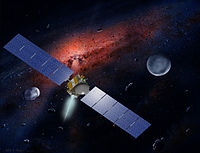
In the early 1990s, NASA initiated the Discovery Program, which was intended to be a series of low-cost scientific missions. In 1996, the program's study team recommended as a high priority a mission to explore the asteroid belt using a spacecraft with an ion engine. Funding for this program remained problematic for several years, but by 2004 the Dawn vehicle had passed its critical design review.[141]
It was launched on 27 September 2007, as the space mission to make the first visits to both Vesta and Ceres. On 3 May 2011, Dawn acquired its first targeting image 1.2 million kilometers from Vesta.[142] After orbiting Vesta for 13 months, Dawn used its ion engine to depart for Ceres, with gravitational capture occurring on 6 March 2015[143] at a separation of 61,000 km,[144] four months prior to the New Horizons flyby of Pluto.
Dawn's mission profile called for it to study Ceres from a series of circular polar orbits at successively lower altitudes. It entered its first observational orbit ("RC3") around Ceres at an altitude of 13,500 km on 23 April 2015, staying for only approximately one orbit (fifteen days).[25][145] The spacecraft subsequently reduced its orbital distance to 4,400 km for its second observational orbit ("survey") for three weeks,[146] then down to 1,470 km ("HAMO;" high altitude mapping orbit) for two months[147] and then down to its final orbit at 375 km ("LAMO;" low altitude mapping orbit) for at least three months.[148]
The spacecraft instrumentation includes a framing camera, a visual and infrared spectrometer, and a gamma-ray and neutron detector. These instruments examined Ceres' shape and elemental composition.[149] On 13 January 2015, Dawn took the first images of Ceres at near-Hubble resolution, revealing impact craters and a small high-albedo spot on the surface, near the same location as that observed previously. Additional imaging sessions, at increasingly better resolution took place on 25 January 4, 12, 19 and 25 February 1 March, and 10 and 15 April.[150]
Pictures with a resolution previously unattained were taken during imaging sessions starting in January 2015 as Dawn approached Ceres, showing a cratered surface. Two distinct bright spots (or high-albedo features) inside a crater (different from the bright spots observed in earlier Hubble images[151]) were seen in a 19 February 2015 image, leading to speculation about a possible cryovolcanic origin[152][153][154] or outgassing.[155] On 3 March 2015, a NASA spokesperson said the spots are consistent with highly reflective materials containing ice or salts, but that cryovolcanism is unlikely.[156] However, on 2 September 2016, scientists from the Dawn team claimed in a Science paper that a massive cryovolcano called Ahuna Mons is the strongest evidence yet for the existence of these mysterious formations.[157][158] On 11 May 2015, NASA released a higher-resolution image showing that, instead of one or two spots, there are actually several.[159] On 9 December 2015, NASA scientists reported that the bright spots on Ceres may be related to a type of salt, particularly a form of brine containing magnesium sulfate hexahydrite (MgSO4·6H2O); the spots were also found to be associated with ammonia-rich clays.[94] In June 2016, near-infrared spectra of these bright areas were found to be consistent with a large amount of sodium carbonate (Na
2CO
3), implying that recent geologic activity was probably involved in the creation of the bright spots.[97][98][100] In July 2018, NASA released a comparison of physical features found on Ceres with similar ones present on Earth.[72] From June to October 2018, Dawn orbited Ceres from as close as 35 km (22 mi) and as far away as 4,000 km (2,500 mi).[160][161] The Dawn mission ended on 1 November 2018 after the spacecraft ran out of fuel.
In October 2015, NASA released a true-color portrait of Ceres made by Dawn.[162] In February 2017, organics (tholins) were detected on Ceres in Ernutet crater (see image).[101][102]
Dawn's arrival in a stable orbit around Ceres was delayed after, close to reaching Ceres, it was hit by a cosmic ray, making it take another, longer route around Ceres in back, instead of a direct spiral towards it.[163]
Maps
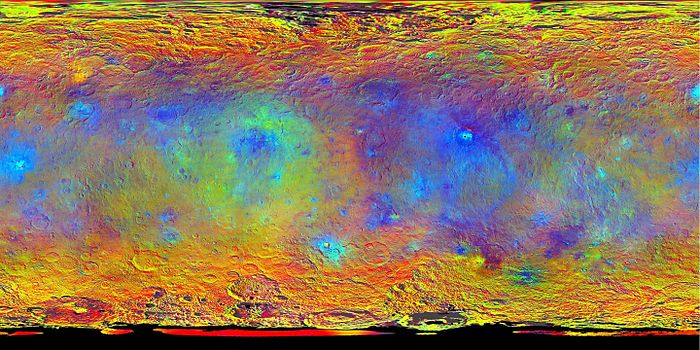 |
 |
 |
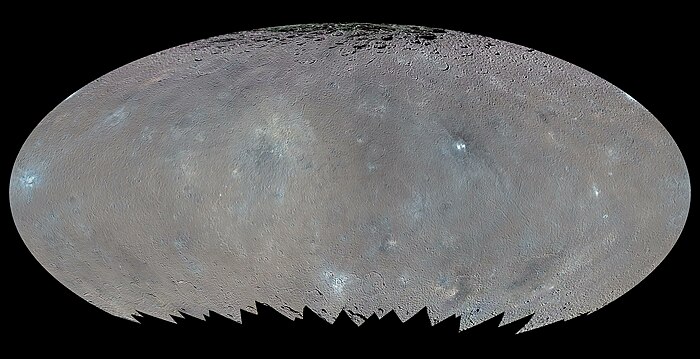 |
 |
 15 km (10 mi) of elevation separate the lowest crater floors (indigo) from the highest peaks (white).[164] |
 |
 |
Map of quadrangles
The following imagemap of Ceres is divided into 15 quadrangles. They are named after the first craters whose names the IAU approved in July 2015.[165] The map image(s) were taken by the Dawn space probe.
Gallery


|

|
-
2004
Hubble Space Telescope -
14 April 2015; Dawn
22,000 km (14,000 mi) -
6 May 2015; Dawn
13,600 km (8,500 mi)

Dawn · Ceres
| Orbit phase | No. | Dates[169] | Altitude (km; mi) |
Orbital period | Resolution (km/px) |
Improvement over Hubble |
Notes |
|---|---|---|---|---|---|---|---|
| RC3 | 1st | 23 April 2015 – 9 May 2015 | 13,500 km (8,400 mi) | 15 days | 1.3 | 24× | |
| Survey | 2nd | 6 June 2015 – 30 June 2015 | 4,400 km (2,700 mi) | 3.1 days | 0.41 | 73× | |
| HAMO | 3rd | 17 August 2015 – 23 October 2015 | 1,450 km (900 mi) | 19 hours | 0.14 (140 m) | 217× | |
| LAMO/XMO1 | 4th | 16 December 2015 – 2 September 2016 | 375 km (233 mi) | 5.5 hours | 0.035 (35 m) | 850× | |
| XMO2 | 5th | 5 October 2016 – 4 November 2016 | 1,480 km (920 mi) | 19 hours | 0.14 (140 m) | 217× | [170][171][172] |
| XMO3 | 6th | 5 December 2016 – 22 February 2018 | 7,520–9,350 km (4,670–5,810 mi) |
≈8 days | 0.9 (est) | 34× (est) | [171] |
| XMO4 | 7th | 22 April 2017 – 22 June 2017 | 13,830–52,800 km (8,590–32,810 mi) |
≈29 days | [173] | ||
| XMO5 | 8th | 30 June 2017 – 16 April 2018 | 4,400–39,100 km (2,700–24,300 mi) |
30 days | [173][174][175] | ||
| XMO6 | 9th | 14 May 2018 – 31 May 2018 | 440–4,700 km (270–2,920 mi) |
37 hours | [176] | ||
| XMO7 (FINAL) | 10th | 6 June 2018 – present | 35–4,000 km (22–2,485 mi) |
27.2 hours | [160][161][177][178] |
-
17 August 2015: Dawn
3rd Map Orbit - HAMO
1,470 km (910 mi)
(1;2;3;4;5;6;7;8;9;10;11;12;13;14;15;16;17;18;19;20;21;22;23;24;25;26;27;28;29;30;31;32;33;34;35;36;37;38;39;40;41;42;43;44;45;46;47;48;49;50;51;52;53;54;55;56;57;58;59;60;61;62;63;64;65;66;67;68;69;70;71;72;73;74;75;76;77;78;79;80;81;82;83;84;85;86;87;88;89) -
10 December 2015: Dawn
4th Map Orbit - LAMOa
385 km (239 mi)
(a;b;c;d;e;1;2;3;4;5;6;7;8;9;10;11;12;13;14;15;16;17;18;19;20;21;22;23;24;25;26;27;28;29;30;31;32;33;34;35;36;37;38;39;40;m1;m2;m3;41;42;43;44;45;46;47;48;49;50;51;52;53;54;55;56;57;58;59;60;61;62;63;64;65;66;67;68;69;70;71;72;73;74;75;76;77;78;79;80;81;82;83) -
10 December 2015: Dawn
4th Map Orbit - LAMOb
385 km (239 mi)
(84;85;86;87;88;89;90;91;92;93;94;95;96;97;98;99;100;101;102;103;104;105;106;107;108;109;110;111;112;113;114;115;116;117;118;119;120;121;122;123;124;125;126;127;128;129;130;131;132;133;134;135;136;137;138;139;140;141;142;143;144;145;146;147;148;149) -
6 June 2018: Dawn
Final Map Orbit
35 km (22 mi)
OccatorCrater:
(Boulders;Landslides;EasternRim-1;EasternRim-2)
(view on commons)
True-color images
Animations
-
4 February 2015; Dawn
90,000 km (56,000 mi) -
29 April 2017: Dawn
20,000 km (12,000 mi) -
4 May 2015; Dawn
13,600 km (8,500 mi)
(simulated; 01:15; 8 June 2015)[179]
(color; 03:43; 29 January 2016)
See also
- Asteroid Belt
- Ceres in fiction
- Former classification of planets
- List of exceptional asteroids
- List of geological features on Ceres
- List of Solar System objects by size
- Mining of Ceres
Notes
- ^ Photograph by the Framing Camera (FC) instrument aboard the Dawn spacecraft on 2 May 2015, during a "rotation characterization" orbit, 13,642 kilometres (8,477 mi) above the surface of Ceres. Visible at center and center right are two bright spots, a phenomenon common on Ceres, in Oxo and Haulani craters respectively. Ahuna Mons is also visible in the image as a noticeable, bluff hill, seen just right of bottom.
- ^ The value given for Ceres is the mean moment of inertia, which is thought to better represent its interior structure than the polar moment of inertia, due to its high polar flattening.[8]
- ^ Due to its eccentric orbit, the dwarf planet Pluto was within the orbit of Neptune from 1979 to 1999, and will be again from approximately 2227 to 2247, but its average orbit is well outside Neptune's.
- ^ In 1807 Klaproth tried to change the name to "cererium", to avoid confusion with the root cēra 'wax' (as in cereous 'waxy'), but it did not catch on.[46]
- ^ This emission rate is modest compared to those calculated for the tidally driven plumes of Enceladus (a smaller body) and Europa (a larger body), 200 kg/s[118] and 7000 kg/s,[119] respectively.
References
- ^ Schmadel, Lutz (2003). Dictionary of minor planet names (5th ed.). Germany: Springer. p. 15. ISBN 978-3-540-00238-3.
- ^ a b c d e f g h i j "1 Ceres". JPL Small-Body Database Browser. Retrieved 8 September 2019.
{{cite web}}: CS1 maint: url-status (link) - ^ "The MeanPlane (Invariable plane) of the Solar System passing through the barycenter". 3 April 2009. Archived from the original on 14 May 2009. Retrieved 10 April 2009. (produced with Solex 10 Archived 29 April 2009 at WebCite written by Aldo Vitagliano; see also Invariable plane)
- ^ a b "AstDyS-2 Ceres Synthetic Proper Orbital Elements". Department of Mathematics, University of Pisa, Italy. Archived from the original on 5 October 2011. Retrieved 1 October 2011.
- ^ a b "Asteroid Ceres P_constants (PcK) SPICE kernel file". Retrieved 8 September 2019.
- ^ a b c d e Calculated based on the known parameters
- ^ Mao, X.; McKinnon, W. B. (2018). "Faster paleospin and deep-seated uncompensated mass as possible explanations for Ceres' present-day shape and gravity". Icarus. 299: 430–442. Bibcode:2018Icar..299..430M. doi:10.1016/j.icarus.2017.08.033.
- ^ a b Park, R. S.; Konopliv, A. S.; Bills, B. G.; Rambaux, N.; Castillo-Rogez, J. C.; Raymond, C. A.; Vaughan, A. T.; Ermakov, A. I.; Zuber, M. T.; Fu, R. R.; Toplis, M. J.; Russell, C. T.; Nathues, A.; Preusker, F. (3 August 2016). "A partially differentiated interior for (1) Ceres deduced from its gravity field and shape". Nature. 537 (7621): 515–517. Bibcode:2016Natur.537..515P. doi:10.1038/nature18955. PMID 27487219.
- ^ a b c Schorghofer, N.; Mazarico, E.; Platz, T.; Preusker, F.; Schröder, S. E.; Raymond, C. A.; Russell, C. T. (6 July 2016). "The permanently shadowed regions of dwarf planet Ceres". Geophysical Research Letters. 43 (13): 6783–6789. Bibcode:2016GeoRL..43.6783S. doi:10.1002/2016GL069368.
- ^ Konopliv, A.S.; Park, R.S.; Vaughan, A.T.; Bills, B.G.; Asmar, S.W.; Ermakov, A.I.; Rambaux, N.; Raymond, C.A.; Castillo-Rogez, J.C.; Russell, C.T.; Smith, D.E.; Zuber, M.T. (2018). "The Ceres gravity field, spin pole, rotation period and orbit from the Dawn radiometric tracking and optical data". Icarus. 299: 411–429. Bibcode:2018Icar..299..411K. doi:10.1016/j.icarus.2017.08.005.
- ^ a b c d e Li, Jian-Yang; McFadden, Lucy A.; Parker, Joel Wm. (2006). "Photometric analysis of 1 Ceres and surface mapping from HST observations". Icarus. 182 (1): 143–160. Bibcode:2006Icar..182..143L. doi:10.1016/j.icarus.2005.12.012.
{{cite journal}}: CS1 maint: multiple names: authors list (link) - ^ a b c d e f "Dawn at Ceres" (PDF).
- ^ a b c Cite error: The named reference
Rivkin2006was invoked but never defined (see the help page). - ^ a b "Dwarf Planet 1 Ceres Information". TheSkyLive.com. Retrieved 26 November 2017.
- ^ "Asteroid (1) Ceres – Summary". AstDyS-2, Asteroids – Dynamic Site. Retrieved 15 October 2019.
- ^ "Ceres". Dictionary.com Unabridged (Online). n.d.
- ^ Stankiewicz, Rick (20 February 2015). "A visit to the asteroid belt". Peterborough Examiner. Archived from the original on 18 May 2016. Retrieved 29 May 2015.
- ^ "Ceres". Solar System Exploration: NASA Science. Retrieved 20 October 2018.
- ^ a b c d e f g h i Raymond, C.; Castillo-Rogez, J.C.; Park, R.S.; Ermakov, A.; et al. (September 2018). "Dawn Data Reveal Ceres' Complex Crustal Evolution" (PDF). European Planetary Science Congress. Vol. 12.
- ^ a b c Parker, J. W.; Stern, Alan S.; Thomas Peter C.; et al. (2002). "Analysis of the first disk-resolved images of Ceres from ultraviolet observations with the Hubble Space Telescope". The Astronomical Journal. 123 (1): 549–557. arXiv:astro-ph/0110258. Bibcode:2002AJ....123..549P. doi:10.1086/338093.
{{cite journal}}: CS1 maint: multiple names: authors list (link) - ^ a b Cite error: The named reference
2016newswas invoked but never defined (see the help page). - ^ Tony Phillips, ed. (22 January 2014). "Water Detected on Dwarf Planet Ceres". Science@NASA. NASA.
- ^ Landau, Elizabeth; Brown, Dwayne (6 March 2015). "NASA Spacecraft Becomes First to Orbit a Dwarf Planet". Jet Propulsion Laboratory. Retrieved 6 March 2015.
- ^ "Dawn Spacecraft Begins Approach to Dwarf Planet Ceres". NASA. Retrieved 29 December 2014.
- ^ a b Rayman, Marc (6 March 2015). "Dawn Journal: Ceres Orbit Insertion!". The Planetary Society. Retrieved 6 March 2015.
- ^ a b c d e f g h i j k Hoskin, Michael (26 June 1992). "Bode's Law and the Discovery of Ceres". Observatorio Astronomico di Palermo "Giuseppe S. Vaiana". Archived from the original on 18 January 2010. Retrieved 5 July 2007.
- ^ a b c d Hogg, Helen Sawyer (1948). "The Titius-Bode Law and the Discovery of Ceres". Journal of the Royal Astronomical Society of Canada. 242: 241–246. Bibcode:1948JRASC..42..241S.
- ^ Hoskin, Michael (1999). The Cambridge Concise History of Astronomy. Cambridge University press. pp. 160–161. ISBN 978-0-521-57600-0.
- ^ Landau, Elizabeth (26 January 2016). "Ceres: Keeping Well-Guarded Secrets for 215 Years". NASA. Retrieved 26 January 2016.
- ^ a b c d e f g Forbes, Eric G. (1971). "Gauss and the Discovery of Ceres". Journal for the History of Astronomy. 2 (3): 195–199. Bibcode:1971JHA.....2..195F. doi:10.1177/002182867100200305.
- ^ Cunningham, Clifford J. (2001). The first asteroid: Ceres, 1801–2001. Star Lab Press. ISBN 978-0-9708162-1-4.
- ^ Hilton, James L. "Asteroid Masses and Densities" (PDF). U.S. Naval Observatory. Retrieved 23 June 2008.
- ^ Hughes, D. W. (1994). "The Historical Unravelling of the Diameters of the First Four Asteroids". R.A.S. Quarterly Journal. 35 (3): 331. Bibcode:1994QJRAS..35..331H. (Page 335)
- ^ Foderà Serio, G.; Manara, A.; Sicoli, P. (2002). "Giuseppe Piazzi and the Discovery of Ceres" (PDF). In W. F. Bottke Jr.; A. Cellino; P. Paolicchi; R. P. Binzel (eds.). Asteroids III. Tucson, Arizona: University of Arizona Press. pp. 17–24. Retrieved 25 June 2009.
- ^ Rüpke, Jörg (2011). A Companion to Roman Religion. John Wiley and Sons. pp. 90–. ISBN 978-1-4443-4131-7.
- ^ "Dawn Spacecraft Finds Traces of Water on Vesta," Sci-Tech Daily, 21 September 2012
- ^ William Thomas Thornton (1878) "Epode 16", Word for word from Horace, page 314
- ^ Rivkin et al. (2012) "The Surface Composition of Ceres," in Christopher Russell & Carol Raymond, eds., The Dawn Mission to Minor Planets 4 Vesta and 1 Ceres, p. 109.
- ^ E.g. Booth (1923) Flowers of Roman poesy
- ^ Simpson, D. P. (1979). Cassell's Latin Dictionary (5th ed.). London: Cassell Ltd. p. 883. ISBN 978-0-304-52257-6.
- ^ Charles Leland (1892) Etruscan Roman Remains, p. 233
- ^ Douglas Brooks-Davies (1989) Fielding, Dickens, Gosse, Iris Murdoch and Oedipal Hamlet, p. 79.
- ^ Unicode value U+26B3
- ^ Gould, B. A. (1852). "On the symbolic notation of the asteroids". Astronomical Journal. 2 (34): 80. Bibcode:1852AJ......2...80G. doi:10.1086/100212.
- ^ "Cerium: historical information". Adaptive Optics. Retrieved 27 April 2007.
- ^ "Cerium". Oxford English Dictionary (Online ed.). Oxford University Press. (Subscription or participating institution membership required.)
- ^ "Amalgamator Features 2003: 200 Years Ago". 30 October 2003. Archived from the original on 7 February 2006. Retrieved 21 August 2006.
- ^ a b c Hilton, James L. (17 September 2001). "When Did the Asteroids Become Minor Planets?". Archived from the original on 18 January 2010. Retrieved 16 August 2006.
- ^ Herschel, William (6 May 1802). "Observations on the two lately discovered celestial Bodies". Philosophical Transactions of the Royal Society of London. 92: 213–232. Bibcode:1802RSPT...92..213H. doi:10.1098/rstl.1802.0010. JSTOR 107120.
- ^ Battersby, Stephen (16 August 2006). "Planet debate: Proposed new definitions". New Scientist. Archived from the original on 5 October 2011. Retrieved 27 April 2007.
- ^ Connor, Steve (16 August 2006). "Solar system to welcome three new planets". NZ Herald. Archived from the original on 5 October 2011. Retrieved 27 April 2007.
- ^ Gingerich, Owen; et al. (16 August 2006). "The IAU draft definition of "Planet" and "Plutons"". IAU. Archived from the original on 5 October 2011. Retrieved 27 April 2007.
- ^ "The IAU Draft Definition of Planets And Plutons". SpaceDaily. 16 August 2006. Archived from the original on 18 January 2010. Retrieved 27 April 2007.
- ^ "In Depth | Ceres". NASA Solar System Exploration.
- ^ Gaherty, Geoff; "How to Spot Giant Asteroid Vesta in Night Sky This Week", 3 August 2011 How to Spot Giant Asteroid Vesta in Night Sky This Week | Asteroid Vesta Skywatching Tips | Amateur Astronomy, Asteroids & Comets | Space.com Archived 5 October 2011 at WebCite
- ^ "Question and answers 2". IAU. Archived from the original on 5 October 2011. Retrieved 31 January 2008.
- ^ Spahr, T. B. (7 September 2006). "MPEC 2006-R19: EDITORIAL NOTICE". Minor Planet Center. Archived from the original on 5 October 2011. Retrieved 31 January 2008.
the numbering of "dwarf planets" does not preclude their having dual designations in possible separate catalogues of such bodies.
- ^ Lang, Kenneth (2011). The Cambridge Guide to the Solar System. Cambridge University Press. pp. 372, 442. ISBN 978-1-139-49417-5.
- ^ NASA/JPL, Dawn Views Vesta, 2 August 2011 Archived 5 October 2011 at WebCite ("Dawn will orbit two of the largest asteroids in the Main Belt").
- ^ de Pater; Lissauer (2010). Planetary Sciences (2nd ed.). Cambridge University Press. ISBN 978-0-521-85371-2.
- ^ Mann, Ingrid; Nakamura, Akiko; Mukai, Tadashi (2009). Small bodies in planetary systems. Lecture Notes in Physics. Vol. 758. Springer-Verlag. ISBN 978-3-540-76934-7.
- ^ "Science: One Mission, Two Remarkable Destinations". NASA. Retrieved 14 July 2020.
Asteroids range in size from Vesta — the largest at about 329 miles (530 kilometers) in diameter...
- ^ a b Cellino, A.; et al. (2002). "Spectroscopic Properties of Asteroid Families" (PDF). Asteroids III. University of Arizona Press. pp. 633–643 (Table on p. 636). Bibcode:2002aste.book..633C.
- ^ Kelley, M. S.; Gaffey, M. J. (1996). "A Genetic Study of the Ceres (Williams #67) Asteroid Family". Bulletin of the American Astronomical Society. 28: 1097. Bibcode:1996DPS....28.1009K.
- ^ Kovačević, A. B. (2011). "Determination of the mass of Ceres based on the most gravitationally efficient close encounters". Monthly Notices of the Royal Astronomical Society. 419 (3): 2725–2736. arXiv:1109.6455. Bibcode:2012MNRAS.419.2725K. doi:10.1111/j.1365-2966.2011.19919.x.
{{cite journal}}: CS1 maint: unflagged free DOI (link) - ^ Christou, A. A. (2000). "Co-orbital objects in the main asteroid belt". Astronomy and Astrophysics. 356: L71–L74. Bibcode:2000A&A...356L..71C.
- ^ Christou, A. A.; Wiegert, P. (January 2012). "A population of Main Belt Asteroids co-orbiting with Ceres and Vesta". Icarus. 217 (1): 27–42. arXiv:1110.4810. Bibcode:2012Icar..217...27C. doi:10.1016/j.icarus.2011.10.016. ISSN 0019-1035.
- ^ "Solex numbers generated by Solex". Archived from the original on 29 April 2009. Retrieved 3 March 2009.
- ^ Rayman, Marc D. (28 May 2015). "Dawn Journal, 28 May 2015". Jet Propulsion Laboratory. Archived from the original on 30 May 2015. Retrieved 29 May 2015.
- ^ Pitjeva, E. V. (2005). "High-Precision Ephemerides of Planets—EPM and Determination of Some Astronomical Constants". Solar System Research. 39 (3): 176–186. Bibcode:2005SoSyR..39..176P. doi:10.1007/s11208-005-0033-2.
- ^ Approximately forty percent that of Australia, a third the size of the US or Canada, 12× that of the UK
- ^ a b Landau, Elizabeth; McCartney, Gretchen (24 July 2018). "What Looks Like Ceres on Earth?". NASA. Retrieved 25 July 2018.
- ^ Thomas, P. C. (July 2010). "Sizes, shapes, and derived properties of the saturnian satellites after the Cassini nominal mission" (PDF). Icarus. 208 (1): 395–401. Bibcode:2010Icar..208..395T. doi:10.1016/j.icarus.2010.01.025.
- ^ Neumann, W.; Breuer, D.; Spohn, T. (2 December 2015). "Modelling the internal structure of Ceres: Coupling of accretion with compaction by creep and implications for the water-rock differentiation" (PDF). Astronomy & Astrophysics. 584: A117. Bibcode:2015A&A...584A.117N. doi:10.1051/0004-6361/201527083.
- ^ a b Bhatia, G.K.; Sahijpal, S. (2017). "Thermal evolution of trans-Neptunian objects, icy satellites, and minor icy planets in the early solar system". Meteoritics & Planetary Science. 52 (12): 2470–2490. Bibcode:2017M&PS...52.2470B. doi:10.1111/maps.12952.
- ^ "Sulfur, Sulfur Dioxide, Graphitized Carbon Observed on Ceres". spaceref.com. 3 September 2016. Retrieved 8 September 2016.
- ^ a b Carry, Benoit; et al. (2007). "Near-Infrared Mapping and Physical Properties of the Dwarf-Planet Ceres" (PDF). Astronomy & Astrophysics. 478 (1): 235–244. arXiv:0711.1152. Bibcode:2008A&A...478..235C. doi:10.1051/0004-6361:20078166. Archived from the original (PDF) on 30 May 2008.
- ^ a b c "Keck Adaptive Optics Images the Dwarf Planet Ceres". Adaptive Optics. 11 October 2006. Archived from the original on 18 January 2010. Retrieved 27 April 2007.
- ^ a b "Largest Asteroid May Be 'Mini Planet' with Water Ice". HubbleSite. 7 September 2005. Archived from the original on 5 October 2011. Retrieved 16 August 2006.
- ^ Cite error: The named reference
presentationwas invoked but never defined (see the help page). - ^ Arizona State University (26 July 2016). "The case of the missing craters". ScienceDaily. Retrieved 8 March 2017.
- ^ Marchi, S.; Ermakov, A. I.; Raymond, C. A.; Fu, R. R.; O'Brien, D. P.; Bland, M. T.; Ammannito, E.; De Sanctis, M. C.; Bowling, T.; Schenk, P.; Scully, J. E. C.; Buczkowski, D. L.; Williams, D. A.; Hiesinger, H.; Russell, C. T. (26 July 2016). "The missing large impact craters on Ceres". Nature Communications. 7: 12257. Bibcode:2016NatCo...712257M. doi:10.1038/ncomms12257. PMC 4963536. PMID 27459197.
- ^ "News – Ceres Spots Continue to Mystify in Latest Dawn Images". NASA/JPL.
- ^ Steigerwald, Bill (2 September 2016). "NASA Discovers "Lonely Mountain" on Ceres Likely a Salty-Mud Cryovolcano". NASA. Retrieved 8 March 2017.
- ^ "Ceres: The tiny world where volcanoes erupt ice". SpaceDaily. 5 September 2016. Retrieved 8 March 2017.
- ^ Sori, Michael M.; Byrne, Shane; Bland, Michael T.; Bramson, Ali M.; Ermakov, Anton I.; Hamilton, Christopher W.; Otto, Katharina A.; Ruesch, Ottaviano; Russell, Christopher T. (2017). "The vanishing cryovolcanoes of Ceres" (PDF). Geophysical Research Letters. 44 (3): 1243–1250. Bibcode:2017GeoRL..44.1243S. doi:10.1002/2016GL072319. hdl:10150/623032.
- ^ "USGS: Ceres nomenclature" (PDF). Retrieved 16 July 2015.
- ^ Rayman, Marc (8 April 2015). Now Appearing At a Dwarf Planet Near You: NASA's Dawn Mission to the Asteroid Belt (Speech). Silicon Valley Astronomy Lectures. Foothill College, Los Altos, CA. Retrieved 7 July 2018.
- ^ Landau, Elizabeth (11 May 2015). "Ceres Animation Showcases Bright Spots". NASA. Retrieved 13 May 2015.
- ^ a b Witze, Alexandra (21 July 2015). "Mystery haze appears above Ceres's bright spots". Nature News. doi:10.1038/nature.2015.18032. Retrieved 23 July 2015.
- ^ Rivkin, Andrew (21 July 2015). "Dawn at Ceres: A haze in Occator crater?". The Planetary Society. Retrieved 8 March 2017.
- ^ "Dawn Mission – News – Detail". NASA.
- ^ Redd, Nola Taylor. "Water Ice on Ceres Boosts Hopes for Buried Ocean [Video]". Scientific American. Retrieved 7 April 2016.
- ^ a b Landau, Elizabeth (9 December 2015). "New Clues to Ceres' Bright Spots and Origins". Jet Propulsion Laboratory. Retrieved 10 December 2015.
- ^ Preferential formation of sodium salts from frozen sodium-ammonium-chloride-carbonate brines – Implications for Ceres' bright spots. Tuan H. Vu, Robert Hodyss, Paul V. Johnson, Mathieu Choukroun. Planetary and Space Science, Volume 141, July 2017, Pages 73–77
- ^ McCord, Thomas B.; Zambon, Francesca (2019). "The surface composition of Ceres from the Dawn mission". Icarus. 318: 2–13. Bibcode:2019Icar..318....2M. doi:10.1016/j.icarus.2018.03.004.
- ^ a b Landau, Elizabeth; Greicius, Tony (29 June 2016). "Recent Hydrothermal Activity May Explain Ceres' Brightest Area". NASA. Retrieved 30 June 2016.
- ^ a b c Lewin, Sarah (29 June 2016). "Mistaken Identity: Ceres Mysterious Bright Spots Aren't Epsom Salt After All". Space.com. Retrieved 30 June 2016.
- ^ De Sanctis, M. C.; et al. (29 June 2016). "Bright carbonate deposits as evidence of aqueous alteration on (1) Ceres". Nature. 536 (7614): 54–57. Bibcode:2016Natur.536...54D. doi:10.1038/nature18290. PMID 27362221.
- ^ a b De Sanctis, M. C.; et al. (29 June 2016). "Bright carbonate deposits as evidence of aqueous alteration on (1) Ceres". Nature. 536 (7614): 54–57. Bibcode:2016Natur.536...54D. doi:10.1038/nature18290. PMID 27362221.
- ^ a b "Dawn discovers evidence for organic material on Ceres (Update)". Phys.org. 16 February 2017. Retrieved 17 February 2017.
- ^ a b c Combe, Jean-Philippe; Singh, Sandeep; Johnson, Katherine E.; McCord, Thomas B.; De Sanctis, Maria Cristina; Ammannito, Eleonora; Carrozzo, Filippo Giacomo; Ciarniello, Mauro; Frigeri, Alessandro; Raponi, Andrea; Tosi, Federico; Zambon, Francesca; Scully, Jennifer E.C.; Raymond, Carol A.; Russell, Christopher T. (2019). "The surface composition of Ceres' Ezinu quadrangle analyzed by the Dawn mission". Icarus. 318: 124–146. Bibcode:2019Icar..318..124C. doi:10.1016/j.icarus.2017.12.039.
- ^ a b Anderson, Paul Scott (27 December 2018). "What does Ceres' carbon mean?". Earth & Sky. Retrieved 27 December 2018.
- ^ a b c d Team finds evidence for carbon-rich surface on Ceres. Southwest Research Institute. Published by PhysOrg. 10 December 2018.
- ^ a b c d e Marchi, S.; Raponi, A.; Prettyman, T. H.; De Sanctis, M. C.; Castillo-Rogez, J.; Raymond, C. A.; Ammannito, E.; Bowling, T.; Ciarniello, M.; Kaplan, H.; Palomba, E.; Russell, C. T.; Vinogradoff, V.; Yamashita, N. (2018). "An aqueously altered carbon-rich Ceres". Nature Astronomy. 3 (2): 140–145. Bibcode:2018NatAs.tmp..181M. doi:10.1038/s41550-018-0656-0.
{{cite journal}}: CS1 maint: bibcode (link) - ^ "PIA20348: Ahuna Mons Seen from LAMO". Jet Propulsion Lab. 7 March 2016. Retrieved 14 April 2016.
- ^ "Catalog Page for PIA22660". photojournal.jpl.nasa.gov.
- ^ "PIA22660: Ceres' Internal Structure (Artist's Concept)". Photojournal. Jet Propulsion Laboratory. 14 August 2018. Retrieved 22 April 2019.
 This article incorporates text from this source, which is in the public domain.
This article incorporates text from this source, which is in the public domain.
- ^ M. Neveu and S. J. Desch (2016) 'Geochemistry, thermal evolution, and cryovolanism on Ceres with a muddy ice mantle'. 47th Lunar and Planetary Science Conference
- ^ "Ceres takes life an ice volcano at a time". University of Arizona. 17 September 2018. Retrieved 22 April 2019.
- ^ A'Hearn, Michael F.; Feldman, Paul D. (1992). "Water vaporization on Ceres". Icarus. 98 (1): 54–60. Bibcode:1992Icar...98...54A. doi:10.1016/0019-1035(92)90206-M.
- ^ Ceres: The Smallest and Closest Dwarf Planet. Space.com 22 January 2014
- ^ Dwarf Planet Ceres, Artist's Impression. 21 January 2014. NASA
- ^ Jewitt, David; Hsieh, Henry; Agarwal, Jessica (2015). Michel, P.; et al. (eds.). The Active Asteroids (PDF). University of Arizona. pp. 221–241. arXiv:1502.02361. Bibcode:2015aste.book..221J. doi:10.2458/azu_uapress_9780816532131-ch012. ISBN 9780816532131. Retrieved 30 January 2020.
{{cite book}}:|journal=ignored (help) - ^ Jewitt, D; Chizmadia, L.; Grimm, R.; Prialnik, D (2007). "Water in the Small Bodies of the Solar System" (PDF). In Reipurth, B.; Jewitt, D.; Keil, K. (eds.). Protostars and Planets V. University of Arizona Press. pp. 863–878. ISBN 978-0-8165-2654-3.
- ^ a b c Küppers, M.; O'Rourke, L.; Bockelée-Morvan, D.; Zakharov, V.; Lee, S.; Von Allmen, P.; Carry, B.; Teyssier, D.; Marston, A.; Müller, T.; Crovisier, J.; Barucci, M. A.; Moreno, R. (23 January 2014). "Localized sources of water vapour on the dwarf planet (1) Ceres". Nature. 505 (7484): 525–527. Bibcode:2014Natur.505..525K. doi:10.1038/nature12918. ISSN 0028-0836. PMID 24451541.
- ^ Campins, H.; Comfort, C. M. (23 January 2014). "Solar system: Evaporating asteroid". Nature. 505 (7484): 487–488. Bibcode:2014Natur.505..487C. doi:10.1038/505487a. PMID 24451536.
- ^ Hansen, C. J.; Esposito, L.; Stewart, A. I.; Colwell, J.; Hendrix, A.; Pryor, W.; Shemansky, D.; West, R. (10 March 2006). "Enceladus' Water Vapor Plume". Science. 311 (5766): 1422–1425. Bibcode:2006Sci...311.1422H. doi:10.1126/science.1121254. PMID 16527971.
- ^ Roth, L.; Saur, J.; Retherford, K. D.; Strobel, D. F.; Feldman, P. D.; McGrath, M. A.; Nimmo, F. (26 November 2013). "Transient Water Vapor at Europa's South Pole" (PDF). Science. 343 (6167): 171–174. Bibcode:2014Sci...343..171R. doi:10.1126/science.1247051. PMID 24336567. Retrieved 26 January 2014.
- ^ O'Brien, D. P.; Travis, B. J.; Feldman, W. C.; Sykes, M. V.; Schenk, P. M.; Marchi, S.; Russell, C. T.; Raymond, C. A. (March 2015). "The Potential for Volcanism on Ceres due to Crustal Thickening and Pressurization of a Subsurface Ocean" (PDF). 46th Lunar and Planetary Science Conference. p. 2831. Retrieved 1 March 2015.
{{cite conference}}: Unknown parameter|booktitle=ignored (|book-title=suggested) (help) - ^ Arizona State University (1 September 2016). "Ceres: The tiny world where volcanoes erupt ice". ScienceDaily. Retrieved 8 March 2017.
- ^ Hiesinger, H.; Marchi, S.; Schmedemann, N.; Schenk, P.; Pasckert, J. H.; Neesemann, A.; OBrien, D. P.; Kneissl, T.; Ermakov, A. I.; Fu, R. R.; Bland, M. T.; Nathues, A.; Platz, T.; Williams, D. A.; Jaumann, R.; Castillo-Rogez, J. C.; Ruesch, O.; Schmidt, B.; Park, R. S.; Preusker, F.; Buczkowski, D. L.; Russell, C. T.; Raymond, C. A. (1 September 2016). "Cratering on Ceres: Implications for its crust and evolution". Science. 353 (6303): aaf4759. Bibcode:2016Sci...353.4759H. doi:10.1126/science.aaf4759. PMID 27701089.
- ^ NASA/Jet Propulsion Laboratory (1 September 2016). "Ceres' geological activity, ice revealed in new research". ScienceDaily. Retrieved 8 March 2017.
- ^ "Confirmed: Ceres Has a Transient Atmosphere". Universe Today. 6 April 2017. Retrieved 14 April 2017.
- ^ Petit, Jean-Marc; Morbidelli, Alessandro (2001). "The Primordial Excitation and Clearing of the Asteroid Belt" (PDF). Icarus. 153 (2): 338–347. Bibcode:2001Icar..153..338P. doi:10.1006/icar.2001.6702. Retrieved 25 June 2009.
- ^ Greicius, Tony (29 June 2016). "Recent Hydrothermal Activity May Explain Ceres' Brightest Area". nasa.gov.
- ^ Snodgrass, Colin; Agarwal, Jessica; Combi, Michael; Fitzsimmons, Alan; Guilbert-Lepoutre, Aurelie; Hsieh, Henry H.; Hui, Man-To; Jehin, Emmanuel; Kelley, Michael S. P. (14 November 2017). "The Main Belt Comets and ice in the Solar System" (PDF). The Astronomy and Astrophysics Review. 25 (1): 5. arXiv:1709.05549. Bibcode:2017A&ARv..25....5S. doi:10.1007/s00159-017-0104-7. ISSN 1432-0754.
- ^ Wall, Mike (2 September 2016). "NASA's Dawn Mission Spies Ice Volcanoes on Ceres". Scientific American. Retrieved 8 March 2017.
- ^ Castillo-Rogez, J. C.; McCord, T. B.; and Davis, A. G. (2007). "Ceres: evolution and present state" (PDF). Lunar and Planetary Science. XXXVIII: 2006–2007. Retrieved 25 June 2009.
{{cite journal}}: CS1 maint: multiple names: authors list (link) - ^ "SPHERE Maps the Surface of Ceres". Retrieved 8 September 2015.
- ^ Menzel, Donald H.; Pasachoff, Jay M. (1983). A Field Guide to the Stars and Planets (2nd ed.). Boston: Houghton Mifflin. p. 391. ISBN 978-0-395-34835-2.
- ^ Martinez, Patrick (1994). The Observer's Guide to Astronomy. Cambridge University Press. p. 298.
- ^ Millis, L. R.; Wasserman, L. H.; Franz, O. Z.; et al. (1987). "The size, shape, density, and albedo of Ceres from its occultation of BD+8°471". Icarus. 72 (3): 507–518. Bibcode:1987Icar...72..507M. doi:10.1016/0019-1035(87)90048-0. hdl:2060/19860021993.
{{cite journal}}: CS1 maint: multiple names: authors list (link) - ^ "Observations reveal curiosities on the surface of asteroid Ceres". Archived from the original on 5 October 2011. Retrieved 16 August 2006.
- ^ a b "Asteroid Occultation Updates". Asteroidoccultation.com. 22 December 2012. Archived from the original on 12 July 2012. Retrieved 20 August 2013.
- ^ "Water Detected on Dwarf Planet Ceres". Science.nasa.gov. Retrieved 24 January 2014.
- ^ Ulivi, Paolo; Harland, David (2008). Robotic Exploration of the Solar System: Hiatus and Renewal, 1983–1996. Springer Praxis Books in Space Exploration. Springer. pp. 117–125. ISBN 978-0-387-78904-0.
- ^ "China's Deep-space Exploration to 2030 by Zou Yongliao Li Wei Ouyang Ziyuan Key Laboratory of Lunar and Deep Space Exploration, National Astronomical Observatories, Chinese Academy of Sciences, Beijing" (PDF).
- ^ https://www.hou.usra.edu/meetings/lpsc2020/pdf/1291.pdf
- ^ https://www.hou.usra.edu/meetings/lpsc2020/pdf/lpsc2020_program.htm#sess333
- ^ Russell, C. T.; Capaccioni, F.; Coradini, A.; et al. (October 2007). "Dawn Mission to Vesta and Ceres" (PDF). Earth, Moon, and Planets. 101 (1–2): 65–91. Bibcode:2007EM&P..101...65R. doi:10.1007/s11038-007-9151-9. Retrieved 13 June 2011.
{{cite journal}}: CS1 maint: multiple names: authors list (link) - ^ Cook, Jia-Rui C.; Brown, Dwayne C. (11 May 2011). "NASA's Dawn Captures First Image of Nearing Asteroid". NASA/JPL. Retrieved 14 May 2011.
- ^ Schenk, P. (15 January 2015). "Year of the 'Dwarves': Ceres and Pluto Get Their Due". Planetary Society. Retrieved 10 February 2015.
- ^ Rayman, Marc (1 December 2014). "Dawn Journal: Looking Ahead at Ceres". Planetary Society. Retrieved 2 March 2015.
- ^ Rayman, Marc (3 March 2014). "Dawn Journal: Maneuvering Around Ceres". Planetary Society. Retrieved 6 March 2015.
- ^ Rayman, Marc (30 April 2014). "Dawn Journal: Explaining Orbit Insertion". Planetary Society. Retrieved 6 March 2015.
- ^ Rayman, Marc (30 June 2014). "Dawn Journal: HAMO at Ceres". Planetary Society. Retrieved 6 March 2015.
- ^ Rayman, Marc (31 August 2014). "Dawn Journal: From HAMO to LAMO and Beyond". Planetary Society. Retrieved 6 March 2015.
- ^ Russel, C. T.; Capaccioni, F.; Coradini, A.; et al. (2006). "Dawn Discovery mission to Vesta and Ceres: Present status". Advances in Space Research. 38 (9): 2043–2048. arXiv:1509.05683. Bibcode:2006AdSpR..38.2043R. doi:10.1016/j.asr.2004.12.041.
{{cite journal}}: CS1 maint: multiple names: authors list (link) - ^ Rayman, Marc (30 January 2015). "Dawn Journal: Closing in on Ceres". Planetary Society. Retrieved 2 March 2015.
- ^ Plait, Phil (11 May 2015). "The Bright Spots of Ceres Spin Into View". Slate. Retrieved 30 May 2015.
- ^ O'Neill, I. (25 February 2015). "Ceres' Mystery Bright Dots May Have Volcanic Origin". Discovery Inc. Retrieved 1 March 2015.
- ^ Landau, E. (25 February 2015). "'Bright Spot' on Ceres Has Dimmer Companion". Jet Propulsion Laboratory. Archived from the original on 26 February 2015. Retrieved 25 February 2015.
- ^ Lakdawalla, E. (26 February 2015). "At last, Ceres is a geological world". The Planetary Society. Retrieved 26 February 2015.
- ^ "LPSC 2015: First results from Dawn at Ceres: provisional place names and possible plumes". The Planetary Society.
- ^ Atkinson, Nancy (3 March 2015). "Bright Spots on Ceres Likely Ice, Not Cryovolcanoes". Universe Today. Retrieved 4 March 2015.
- ^ Sundermier, Ali. "NASA just found an ice volcano on Ceres that's half the size of Everest". ScienceAlert. Retrieved 5 September 2016.
- ^ Ruesch, O.; Platz, T.; Schenk, P.; McFadden, L. A.; Castillo-Rogez, J. C.; Quick, L. C.; Byrne, S.; Preusker, F.; O'Brien, D. P. (2 September 2016). "Cryovolcanism on Ceres". Science. 353 (6303): aaf4286. Bibcode:2016Sci...353.4286R. doi:10.1126/science.aaf4286. ISSN 0036-8075. PMID 27701087.
- ^ "Ceres RC3 Animation". Jet Propulsion Laboratory. 11 May 2015. Retrieved 31 July 2015.
- ^ a b Rayman, Marc (13 June 2018). "Dawn – Mission Status". Jet Propulsion Laboratory. Retrieved 16 June 2018.
- ^ a b Clark, Stephen (15 June 2018). "Dawn spacecraft flying low over Ceres". SpaceFlightNow.com. Retrieved 16 June 2018.
- ^ "Dawn data from Ceres publicly released: Finally, color global portraits!". The Planetary Society. Retrieved 9 November 2015.
- ^ "Dawn Operating Normally After Safe Mode Triggered". NASA/JPL. 16 September 2014. Archived from the original on 25 December 2014. Retrieved 18 March 2015.
- ^ Landau, Elizabeth (28 July 2015). "New Names and Insights at Ceres". NASA. Retrieved 28 July 2015.
- ^ Staff (17 July 2015). "First 17 Names Approved for Features on Ceres". USGS. Archived from the original on 6 August 2015. Retrieved 9 August 2015.
- ^ Krummheuer, B. (25 February 2015). "Dawn: Two new glimpses of dwarf planet Ceres". Max Planck Institute for Solar System Research. Retrieved 26 February 2015.
- ^ Rayman, Marc (25 February 2015). "Dawn Journal: Ceres' Deepening Mysteries". Planetary Society. Retrieved 25 February 2015.
- ^ Rayman, Marc (31 March 2015). "Dawn Journal March 31 [2015]". NASA / Jet Propulsion Laboratory. Archived from the original on 5 September 2015. Retrieved 9 September 2015.
- ^ Rayman, Marc (30 July 2015). "Dawn Journal: Descent to HAMO". The Planetary Society. Retrieved 9 September 2015.
- ^ "PIA21221: Dawn XMO2 Image 1". NASA / Jet Propulsion Laboratory. 7 November 2016. Retrieved 20 November 2016.
- ^ a b "Dawn Mission Status Updates". NASA / Jet Propulsion Laboratory. 16 October 2015. Archived from the original on 28 November 2017. Retrieved 17 October 2015.
- ^ Rayman, Marc D. (28 November 2016). "Dawn Journal". NASA/JPL. Archived from the original on 1 May 2017. Retrieved 8 March 2017.
- ^ a b Rayman, Marc (2017). "2017 Mission Status Updates". NASA / Jet Propulsion Laboratory.
- ^ Rayman, Marc (25 May 2018). "Dawn Journal: Getting Elliptical". The Planetary Society. Retrieved 5 June 2018.
- ^ Rayman, Marc (20 March 2018). "Dear Vernal Dawnquinoxes". NASA. Retrieved 5 June 2018.
- ^ Rayman, Marc (2018). "2018 Mission Status Archive". NASA / Jet Propulsion Laboratory.
- ^ Kornfeld, Laurel (2 June 2018). "Dawn will enter lowest ever orbit around Ceres". Spaceflight Insider. Retrieved 5 June 2018.
- ^ Rayman, Marc (29 April 2018). "Dear Isaac Newdawn, Charles Dawnwin, Albert Einsdawn and all other science enthusiasts". NASA. Retrieved 5 June 2018.
- ^ Landau, Elizabeth; Dyches, Preston (8 June 2015). "Fly Over Ceres in New Video". NASA. Retrieved 9 June 2015.
External links
- Ceres Trek – An integrated map browser of datasets and maps for 1 Ceres
- Ceres 3D Model – NASA
- Destination Ceres:Breakfast at Dawn – NASA
- Dawn mission home page at JPL
- Simulation of the orbit of Ceres
- Google Ceres 3D, interactive map of the dwarf planet
- How Gauss determined the orbit of Ceres from keplersdiscovery.com
- Animated reprojected colorized map of Ceres (22 February 2015)
- Rotating relief model of Ceres by Seán Doran (about 60% of a full rotation; starts with Occator midway above center)
- Ceres (dwarf planet) at AstDyS-2, Asteroids—Dynamic Site
- Ceres at the JPL Small-Body Database
- Solar System
- Minor planet object articles (numbered)
- Ceres (dwarf planet)
- Background asteroids
- Active asteroids
- Discoveries by Giuseppe Piazzi
- Minor planets named from Roman mythology
- Named minor planets
- Minor planets visited by spacecraft
- Objects observed by stellar occultation
- C-type asteroids (SMASS)
- G-type asteroids (Tholen)
- Astronomical objects discovered in 1801




